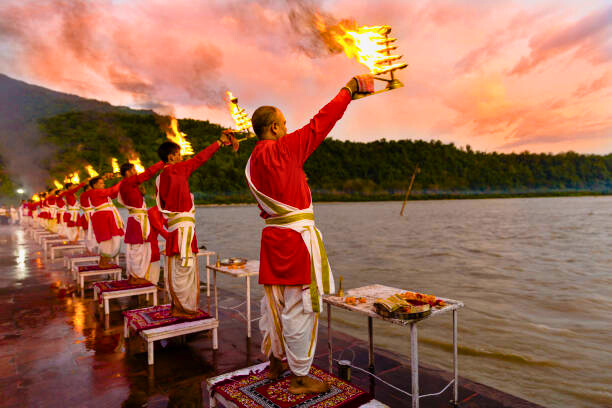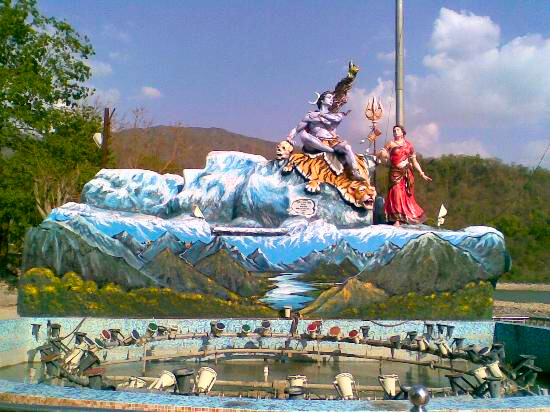Triveni Ghat: A Sacred Confluence of Spirituality and Serenity
Rishikesh, the ‘Yoga Capital of the World,’ is renowned for its spiritual aura, ancient temples, and the tranquil flow of the River Ganges. One of the most sacred and significant places in Rishikesh is Triveni Ghat. This revered riverbank is a spiritual epicenter where pilgrims and tourists gather to witness the confluence of faith, tradition, and nature. Triveni Ghat derives its name from the Sanskrit words ‘Tri’ (three) and ‘Veni’ (confluence), signifying the meeting point of three holy rivers—Ganga, Yamuna, and the mythical Saraswati. The ghat is not only a religious landmark but also an embodiment of India’s rich cultural and historical heritage.
Historical and Mythological Significance
Triveni Ghat has deep-rooted connections with Hindu mythology and history. It is believed that Lord Krishna visited this ghat after being wounded by an arrow shot by the hunter Jara. The Mahabharata also narrates that Lord Krishna performed penance at Triveni Ghat to cleanse himself of the sins of war. Additionally, this site is mentioned in the Ramayana, where Lord Rama and his brother Lakshmana are said to have bathed in these waters to atone for their sins after slaying Ravana.
The ghat’s spiritual significance is further amplified by its association with the unseen Saraswati River, which is believed to join the Ganga and Yamuna underground. The idea of Triveni (three rivers) holds immense religious importance in Hindu philosophy, symbolizing the ultimate purity and moksha (liberation).
The Spiritual Essence and Rituals
One of the primary attractions of Triveni Ghat is its daily Ganga Aarti, a mesmerizing ritual that takes place at dusk. This grand event sees hundreds of devotees gathering to witness the priests performing an elaborate prayer with large brass lamps (diyas), chanting Vedic hymns, and offering flowers to the sacred river. The synchronized movements of the priests, the rhythmic sound of conch shells, and the shimmering reflections of the flames on the water create an ethereal ambiance.
Apart from the aarti, Triveni Ghat is a hub for various religious activities, including:
- Morning and evening prayers
- Holy dips in the Ganges, which are believed to cleanse one’s sins
- Pind Daan and Shraddh rituals, performed for the peace of departed souls
- Yajnas and homas, performed by priests to invoke divine blessings
Devotees often feed the fish in the river as an act of offering, believing that it brings prosperity and good karma. The entire atmosphere of the ghat reverberates with chants of ‘Har Har Gange,’ instilling a deep sense of peace and devotion.
Architectural and Natural Beauty
While Triveni Ghat is a site of religious significance, it is also an architectural and natural marvel. The ghat has been designed to accommodate a large number of pilgrims, with broad steps leading down to the river, well-maintained platforms, and numerous temples in the vicinity. The presence of the iconic Gita Mandir and Lakshminarayan Temple nearby adds to the spiritual aura of the place.
The natural surroundings of Triveni Ghat enhance its charm. The flowing Ganges, the gentle rustling of peepal trees, and the sight of the distant Himalayan foothills create a picturesque setting. Early mornings at Triveni Ghat offer a breathtaking view of the rising sun reflecting on the serene waters, making it a haven for meditation and introspection.
For more information you can visit : click here


Cultural and Social Impact
Triveni Ghat is not just a religious destination but also a cultural hub. It serves as a meeting point for saints, sadhus, and yogis from different parts of the world. Many yoga practitioners and spiritual seekers visit the ghat to experience its tranquil vibrations and connect with their inner selves.
The ghat also plays a vital role in various religious festivals. During occasions like Makar Sankranti, Ganga Dussehra, and Kartik Purnima, the ghat is thronged with devotees who perform special pujas and take ceremonial dips in the river. The vibrancy and energy of these festivals reflect the deep cultural roots of Hinduism and its strong connection with nature.
Apart from its spiritual relevance, Triveni Ghat also contributes to the local economy. The surrounding markets offer a variety of items such as rudraksha beads, idols, spiritual books, and traditional handicrafts, attracting tourists and pilgrims alike. The area is also home to numerous ashrams and guesthouses, making it a popular destination for long-term visitors seeking spiritual rejuvenation.
Environmental and Conservation Efforts
Given its significance, preserving the sanctity of Triveni Ghat is of paramount importance. Over the years, various initiatives have been undertaken to keep the river clean and the ghat well-maintained. The Namami Gange project, launched by the Indian government, focuses on cleaning the Ganges and ensuring that pollutants do not degrade the water quality.
Local NGOs and volunteers often organize cleanliness drives, educating pilgrims about the importance of maintaining hygiene at the ghat. There is also an increased emphasis on using eco-friendly materials for religious offerings to prevent water pollution. The rise in awareness has led to better waste management systems and responsible tourism practices in the area.
Experiencing Triveni Ghat
A visit to Triveni Ghat is more than just a sightseeing experience—it is a journey into the soul of India’s spiritual ethos. Whether one is seeking divine blessings, peace of mind, or simply an escape from the chaos of daily life, Triveni Ghat provides an unparalleled sense of solace.
For the best experience, visitors are advised to:
- Attend the evening Ganga Aarti for an unforgettable spiritual encounter
- Take a holy dip in the river to feel refreshed and rejuvenated
- Visit the nearby temples to delve deeper into Hindu mythology
- Explore the local market for unique souvenirs and spiritual artifacts
- Meditate on the ghat during early morning hours for an enriching experience
Nearby Attractions
Apart from Triveni Ghat, Rishikesh boasts several attractions that visitors can explore:
- Lakshman Jhula: An iconic suspension bridge over the Ganges, offering breathtaking views and access to temples and ashrams.
- Ram Jhula: Another famous suspension bridge, similar to Lakshman Jhula, linking important pilgrimage sites.
- Parmarth Niketan Ashram: A well-known spiritual retreat offering yoga, meditation, and spiritual discourses.
- Neelkanth Mahadev Temple: A revered temple dedicated to Lord Shiva, situated amidst lush greenery about 32 km from Rishikesh.
- Beatles Ashram (Chaurasi Kutiya): The ashram where the Beatles stayed in the 1960s, now a peaceful site for meditation and exploration.
- Swarg Ashram: One of the oldest ashrams in Rishikesh, perfect for meditation and spiritual growth.
- Vashishta Gufa: A serene cave where the sage Vashishta is believed to have meditated, offering a tranquil escape for seekers.
- Rajaji National Park: A wildlife sanctuary near Rishikesh, home to diverse flora and fauna, including elephants and tigers.
Frequently Asked Questions (FAQs)
1. What is the best time to visit Triveni Ghat?
The best time to visit Triveni Ghat is during the winter months (October to March) when the weather is pleasant. The evening Ganga Aarti is a must-experience event.
2. Is there an entry fee for Triveni Ghat?
No, there is no entry fee to visit Triveni Ghat. It is open to the public and accessible to all visitors.
3. Can tourists participate in the Ganga Aarti?
Yes, tourists can actively participate in the Ganga Aarti by offering diyas and flowers to the river. Some ashrams and temples also offer special bookings for aarti participation.
4. What are the nearby attractions to Triveni Ghat?
Some of the nearby attractions include Lakshman Jhula, Ram Jhula, Parmarth Niketan Ashram, Beatles Ashram, and Neelkanth Mahadev Temple.
5. Is it safe to take a dip in the Ganges at Triveni Ghat?
Yes, it is generally safe to take a dip in the Ganges at Triveni Ghat. However, visitors should be cautious of the river’s currents and avoid deep waters.
6. Are there accommodation options near Triveni Ghat?
Yes, there are several hotels, guesthouses, and ashrams near Triveni Ghat that offer comfortable stays for pilgrims and tourists.
Conclusion
Triveni Ghat, Rishikesh, stands as a beacon of devotion, faith, and timeless spirituality. Its profound historical, cultural, and religious significance makes it a must-visit destination for seekers of divinity and inner peace. The harmonious blend of spiritual rituals, natural beauty, and the ever-flowing Ganges creates an experience that leaves an indelible mark on every visitor’s heart.
Whether you are drawn by faith, history, or the mesmerizing evening aarti, Triveni Ghat offers a sacred retreat from the material world, inviting everyone to immerse themselves in the divine essence of the Ganges. It is not just a place but a spiritual experience—one that transcends time and touches the soul.



Leave a Reply